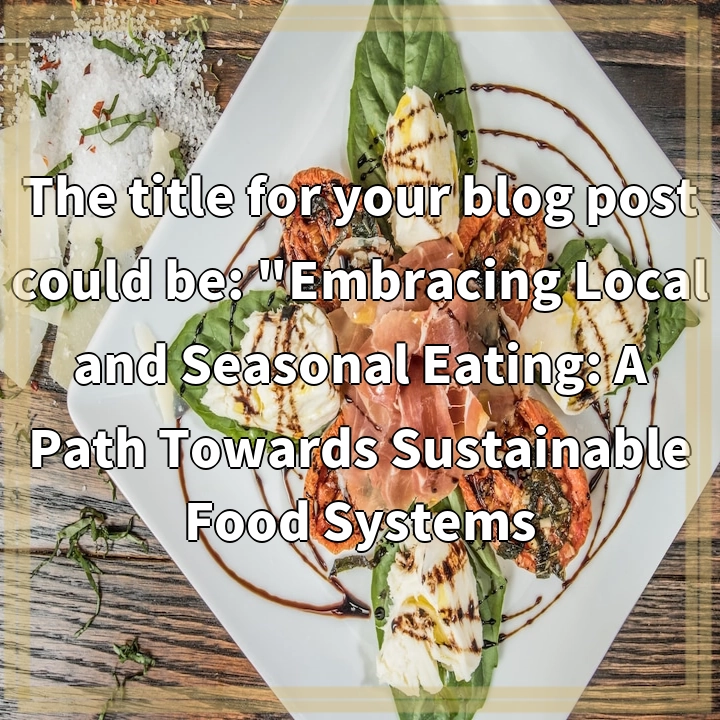
What it is:
Embracing Local and Seasonal Eating: A Path Towards Sustainable Food Systems
Local and seasonal eating is a food consumption practice that focuses on consuming foods that are produced and harvested within close proximity to one’s location, and at the time of their natural harvest. This approach promotes the use of locally available produce, meats, and dairy products, and encourages individuals to eat in sync with the seasons. The aim is to reduce the carbon footprint associated with food transportation, support local farmers and businesses, and promote food security.
Real-world problems:
While local and seasonal eating holds numerous benefits, there are also several challenges and obstacles that need to be considered:
1. Limited availability:
Local and seasonal eating can be challenging in areas where the climate or geography restricts the availability of certain foods. This can make it difficult for individuals to have access to a diverse range of nutrients throughout the year, particularly in regions with harsh winters or limited agricultural resources.
2. Consumer demand and convenience:
There is often a lack of consumer demand for local and seasonal foods due to the convenience and easy access to a wide array of imported and out-of-season produce at grocery stores. Many individuals prioritize convenience and may not be willing to put in the effort to seek out local options or adjust their eating habits according to seasonal patterns.
3. Lack of awareness and education:
Many people are simply not aware of the benefits of local and seasonal eating or may lack the knowledge and skills required to incorporate it into their daily lives. Without education and awareness campaigns, it can be difficult to build a widespread understanding of the importance of this practice and motivate individuals to make changes.
4. Industrial food system dominance:
The dominant industrial food system, with its standardized production and global supply chains, often prioritizes efficiency and profit over sustainability and local production. This creates challenges for small-scale local farmers and producers who struggle to compete with larger industrial operations.
5. Food waste and preservation:
Local and seasonal eating may require individuals to adapt their cooking and food preservation practices. Without the availability of certain produce year-round, it can be challenging to avoid food waste and to store and preserve foods for the off-season.
Despite these challenges, embracing local and seasonal eating remains a crucial aspect of building a more sustainable food system. By addressing these problems, creating awareness, and implementing supportive policies, individuals and communities can work towards a future where local and seasonal eating is the norm.

Solutions for Local and Seasonal Eating:
While there are challenges associated with local and seasonal eating, there are also potential solutions that can help overcome these obstacles:
1. Community Supported Agriculture (CSA) programs:
CSA programs allow individuals to directly support local farmers by subscribing to receive a share of the farm’s produce each season. By participating in CSA programs, consumers can enjoy access to fresh, local and seasonal produce while supporting local farmers.
2. Farmer’s markets and farm-to-table restaurants:
Farmer’s markets provide a platform for local farmers and producers to sell their goods directly to consumers, promoting local and seasonal eating. Similarly, farm-to-table restaurants prioritize using locally sourced ingredients, helping to create demand for local and seasonal foods while supporting local businesses.
3. Education and awareness initiatives:
Increasing education and awareness about the benefits of local and seasonal eating is crucial. This can be done through public campaigns, school programs, and community workshops, helping individuals understand the environmental and health advantages of choosing local foods.
4. Policy support:
Governments can play a role in supporting local and seasonal eating by implementing policies that prioritize sustainability and support local food systems. This can include creating incentives for local farmers, implementing labeling requirements for imported and out-of-season foods, and supporting initiatives to reduce food waste.
5. Food preservation techniques:
By learning and adopting various food preservation techniques such as canning, freezing, or fermenting, individuals can extend the shelf life of local and seasonal produce. This can help overcome the limited availability of certain foods during off-seasons and reduce food waste.
By implementing these solutions, individuals, communities, and policymakers can work together to promote local and seasonal eating. This can help create more sustainable food systems, support local economies, and reduce the carbon footprint associated with food production and transportation.















